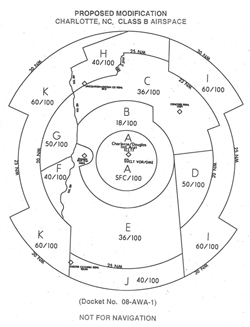 The FAA is moving forward with its plans to expand the Class B airspace surrounding North Carolina’s Charlotte/Douglas International Airport and has published a notice of proposed rulemaking (NPRM) outlining the proposed airspace modifications.
The FAA is moving forward with its plans to expand the Class B airspace surrounding North Carolina’s Charlotte/Douglas International Airport and has published a notice of proposed rulemaking (NPRM) outlining the proposed airspace modifications.
The FAA says in the NPRM that the changes are necessary to ensure that airliners remain within the Class B airspace, to accommodate implementation of area navigation (RNAV) departure procedures, and to support operations from a third parallel runway.
During initial meetings on the proposal, AOPA raised concerns about its effects on two busy general aviation airports. One of them, Chester Catawba Regional Airport in Chester, S.C., more than 25 nm southwest of Charlotte, is the area’s largest skydiving operation. The airport’s location is outside today’s Class B airspace but would lie beneath the expanded Class B—and its skydiving operations would be impacted.
“We are encouraged that the FAA has proposed some mitigation options that may alleviate the burden of the proposed changes on the skydiving operation,” said Tom Kramer, AOPA manager of air traffic services. Lancaster County-McWhirter Field in Lancaster, S.C., more than 25 nm south of Charlotte/Douglas, also is located outside the current Class B airspace, and will lie beneath it if the airspace is expanded.
AOPA has participated in the airspace design process as a member of the ad hoc airspace users’ committee, and submitted preliminary comments to the FAA suggesting alternatives that would mitigate the impact of the proposed changes on airports underlying the Class B airspace. While the FAA has adopted some of the airspace users’ recommendations, the agency has been reluctant to allow low-altitude aircraft transiting the airspace to use RNAV T routes established in 2005 for that purpose.
Member input indicates that Charlotte Approach continues to route low-level IFR traffic around the Charlotte Class B airspace, instead of utilizing the more direct RNAV T routes. “If these routes conflict with arrivals and departures into Charlotte, the FAA needs to evaluate and potentially rework those T routes to offer a workable solution,” Kramer said. “T routes should provide a direct routing option for IFR traffic that must be available, but members report that IFR flights are being rerouted in excess of 30 nm, and that they are not being allowed to take advantage of RNAV benefits.”
AOPA has told the FAA that the Class B redesign should consider all traffic in the Charlotte metropolitan area, not just commercial traffic arriving and departing at the hub airport, and will cite the inability of pilots to utilize the Charlotte RNAV T routes in its response to the NPRM.
Comments on the NPRM must be submitted to the FAA by May 3, 2010. Members who fly in the area or who will be impacted by these proposed changes are encouraged to file comments before the deadline.



